Dune Sunflower, Beach Sunflower, Cucumberleaf Sunflower, East Coast Dune Sunflower, Branching Sunflower - Helianthus debilis
|
Helianthus debilis - Dune Sunflower, Beach Sunflower, Cucumberleaf Sunflower, East Coast Dune Sunflower, Branching Sunflower. The USDA Common name is Cucumberleaf Sunflower, but Beach Sunflower and Dune Sunflower seem to be the most commonly used common names.
Until 1969, Helianthus debilis was considered to have 8 subspecies. In 1969, however, 3 of those subspecies found only in Texas were moved to the separate species Helianthus praecox (Texas Sunflower), leaving 5 subspecies in Helianthus debilis. Of these, Helianthus debilis ssp. silvestris is also found only in Texas. Subspecies debilis and vestitus are found only in Florida, and subspecies tardiflorus is found in Florida, Georgia, Alabama, and Mississippi. Subspecies cucumerifolius is the most widespread subspecies, found 17 mostly coastal states.
Found in:
AL, CT, FL, GA, LA, MA, MD, ME, MI, MS, NC, NH, PA, RI, SC, TX, VA, VT, WV
Leave comments on Helianthus debilis at this link. | 
Distribution of Helianthus debilis in the United States and Canada:

Blue=Native; Grey=Introduced
Map from USDA Plants Database:
USDA, NRCS. 2017. The PLANTS Database (http://plants.usda.gov, 08 May 2025). National Plant Data Team, Greensboro, NC 27401-4901 USA.
Search Our Database: Enter any portion of the Scientific, Common Name, or both.
Do a general Google search of the entire site:
#ad
 Follow USWildflowers on Twitter
#ad
| | Site: Bradenton Beach, Manatee County, FL Date: 2011-December-20 | Photographer: Gerald C. Williamson
Nikon D7000
| | The blossom of this composite will have between 11 and 20 yellow ray florets, and more than 30 disk florets. The disk florets are usually have dark reddish-brown lobes (although reported to occasionally be yellow) and a yellow corolla tube. The anthers are usually dark red. The blossom may be up to around 2.5 inches across. The plant may bloom year-round in the southern parts of its range. | | 
| | Site: Bradenton Beach, Manatee County, FL Date: 2011-December-20 | Photographer: Gerald C Williamson
Nikon D7000 | | Leaf variations are amongst the attributes that help determine the subspecies. Most are alternate with petioles between 1/2" and 3" long. They usually have some degree of serration. | | Click on the photo for a larger image
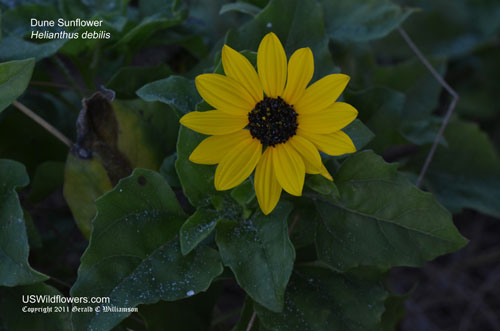
| | Site: Desoto National Monument, Manatee County, FL Date: 2011-December-21 | Photographer: Gerald C Williamson
Nikon D7000 | | Helianthus debilis can grow in large colonies, making an attractive ground cover. | | Click on the photo for a larger image
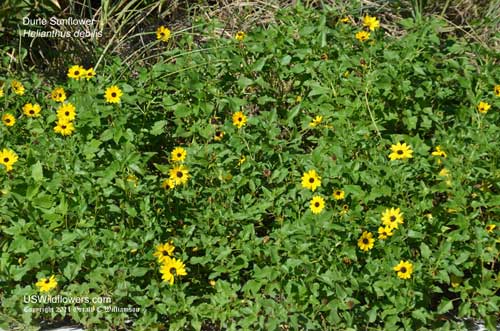
| | Site: Ft. Desoto County Park, Pinellas County, FL Date: 2011-December-19 | Photographer: Gerald C Williamson
Nikon D7000 | | Dune Sunflower height is greatly variable. It can be less than a foot tall, or may reach 6 feet in height. The peduncles (flower stalks) may be between 3" and 20" long, depending on the subspecies. | | Click on the photo for a larger image
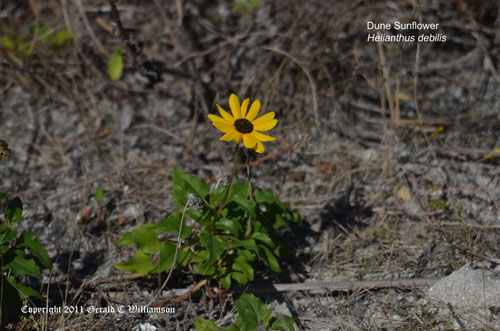
| | Site: Bradenton Beach, Manatee County, FL Date: 2011-December-20 | Photographer: Gerald C Williamson
Nikon D7000 | | The involucre has 30 to 40 long, usually spreading phyllaries. They may be slightly hairy. | | Click on the photo for a larger image
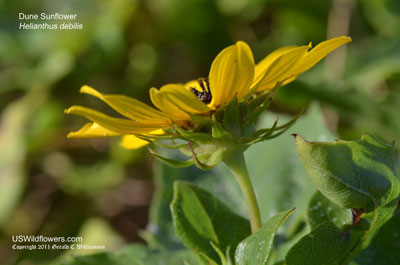
| | Site: Bradenton Beach, Manatee County, FL Date: 2011-December-20 | Photographer: Gerald C Williamson
Nikon D7000 | | This sunflower is quite salt tolerant, and grows in sandy soil in full sun. The Dune Sunflower and Beach name is appropriate, as it can be found along the dunes at beaches along the coastal areas of its range. | | Click on the photo for a larger image
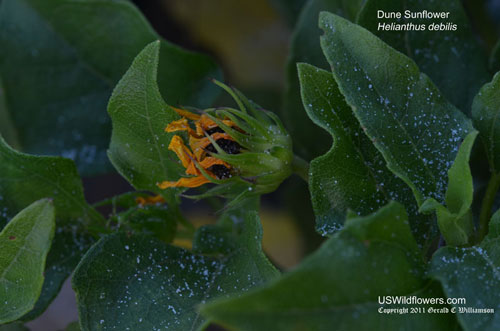
|
References used for identification and information:
|
|
| |
| #ad
|
|








